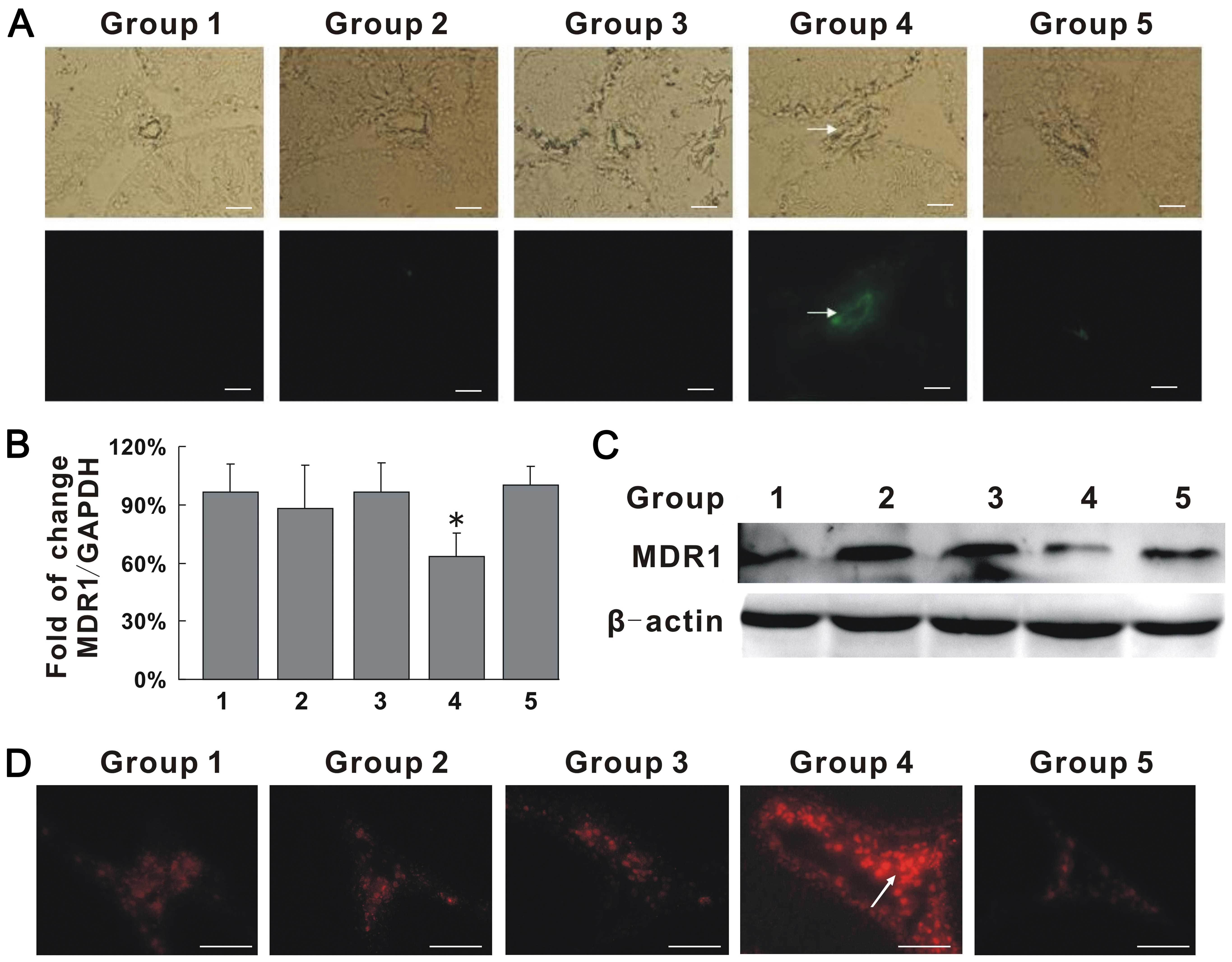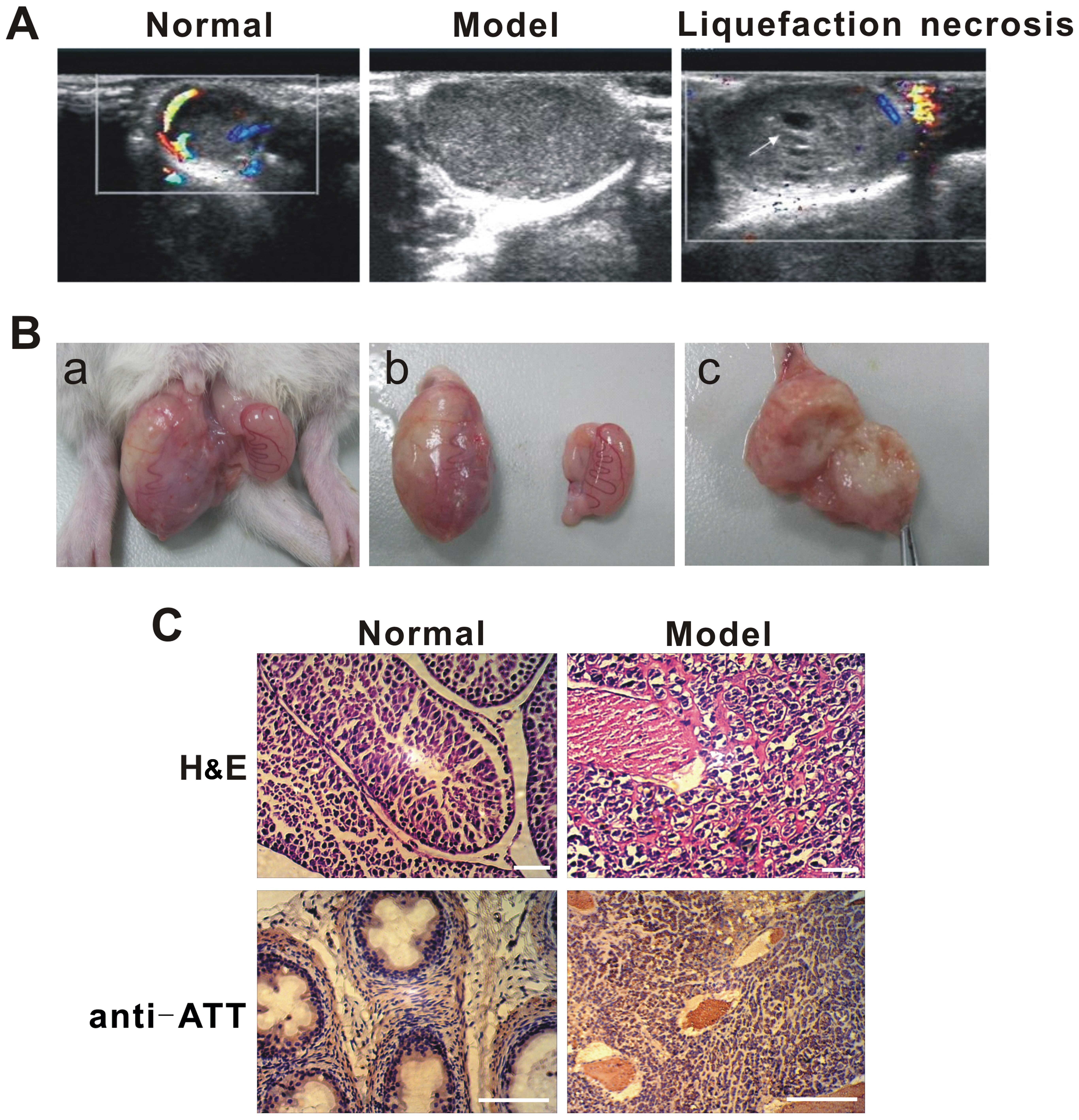|
1
|
Nakamura T and Miki T: Recent strategy for
the management of advanced testicular cancer. Int J Urol.
17:148–157. 2010. View Article : Google Scholar : PubMed/NCBI
|
|
2
|
Allaway M, Nseyo UO and Kandzari SJ:
Primary testicular sarcoma. J Urol. 163:18712000. View Article : Google Scholar : PubMed/NCBI
|
|
3
|
Kawai K and Akaza H: Current status of
chemotherapy in risk-adapted management for metastatic testicular
germ cell cancer. Cancer Sci. 101:22–28. 2010. View Article : Google Scholar
|
|
4
|
Schrader AJ, Seger M, Konrad L, Olbert P,
Hegele A, Hofmann R and Heidenreich A: Clinical impact of
MDR1-expression in testicular germ cell cancer. Exp Oncol.
29:212–216. 2007.PubMed/NCBI
|
|
5
|
Bart J, Hollema H, Groen HJ, de Vries EG,
Hendrikse NH, Sleijfer DT, Wegman TD, Vaalburg W and van der Graaf
WT: The distribution of drug-efflux pumps, P-gp, BCRP, MRP1 and
MRP2, in the normal blood-testis barrier and in primary testicular
tumours. Eur J Cancer. 40:2064–2070. 2004. View Article : Google Scholar : PubMed/NCBI
|
|
6
|
Kimura Y, Matsuo M, Takahashi K, Saeki T,
Kioka N, Amachi T and Ueda K: ATP hydrolysis-dependent multidrug
efflux transporter: MDR1/P-glycoprotein. Curr Drug Metab. 5:1–10.
2004. View Article : Google Scholar : PubMed/NCBI
|
|
7
|
Sivapackiam J, Harpstrite SE, Prior JL, Gu
H, Rath NP and Sharma V: Synthesis, molecular structure, and
validation of metalloprobes for assessment of MDR1
P-glycoprotein-mediated functional transport. Dalton Trans.
39:5842–5850. 2010. View
Article : Google Scholar : PubMed/NCBI
|
|
8
|
Bart J, Groen HJ, van der Graaf WT,
Hollema H, Hendrikse NH, Vaalburg W, Sleijfer DT and de Vries EG:
An oncological view on the blood-testis barrier. Lancet Oncol.
3:357–363. 2002. View Article : Google Scholar : PubMed/NCBI
|
|
9
|
He Y, Bi Y, Hua Y, Liu D, Wen S, Wang Q,
Li M, Zhu J, Lin T, He D, et al: Ultrasound microbubble-mediated
delivery of the siRNAs targeting MDR1 reduces drug resistance of
yolk sac carcinoma L2 cells. J Exp Clin Cancer Res. 30:1042011.
View Article : Google Scholar : PubMed/NCBI
|
|
10
|
Shi Z, Liang YJ, Chen ZS, Wang XW, Wang
XH, Ding Y, Chen LM, Yang XP and Fu LW: Reversal of
MDR1/P-glycoprotein-mediated multidrug resistance by vector-based
RNA interference in vitro and in vivo. Cancer Biol Ther. 5:39–47.
2006. View Article : Google Scholar
|
|
11
|
Yin H, Kanasty RL, Eltoukhy AA, Vegas AJ,
Dorkin JR and Anderson DG: Non-viral vectors for gene-based
therapy. Nat Rev Genet. 15:541–555. 2014. View Article : Google Scholar : PubMed/NCBI
|
|
12
|
Carson AR, McTiernan CF, Lavery L, Hodnick
A, Grata M, Leng X, Wang J, Chen X, Modzelewski RA and Villanueva
FS: Gene therapy of carcinoma using ultrasound-targeted
micro-bubble destruction. Ultrasound Med Biol. 37:393–402. 2011.
View Article : Google Scholar : PubMed/NCBI
|
|
13
|
Carson AR, McTiernan CF, Lavery L, Grata
M, Leng X, Wang J, Chen X and Villanueva FS: Ultrasound-targeted
microbubble destruction to deliver siRNA cancer therapy. Cancer
Res. 72:6191–6199. 2012. View Article : Google Scholar : PubMed/NCBI
|
|
14
|
Bi Y, He Y, Huang J, Su Y, Zhu GH, Wang Y,
Qiao M, Zhang BQ, Zhang H, Wang Z, et al: Functional
characteristics of reversibly immortalized hepatic progenitor cells
derived from mouse embryonic liver. Cell Physiol Biochem.
34:1318–1338. 2014. View Article : Google Scholar : PubMed/NCBI
|
|
15
|
Bi Y, Gong M, He Y, Zhang X, Zhou X, Zhang
Y, Nan G, Wei X, Liu Y, Chen J, et al: AP2α transcriptional
activity is essential for retinoid-induced neuronal differentiation
of mesenchymal stem cells. Int J Biochem Cell Biol. 46:148–160.
2014. View Article : Google Scholar
|
|
16
|
Nettersheim D, Westernströer B, Haas N,
Leinhaas A, Brüstle O, Schlatt S and Schorle H: Establishment of a
versatile seminoma model indicates cellular plasticity of germ cell
tumor cells. Genes Chromosomes Cancer. 51:717–726. 2012. View Article : Google Scholar : PubMed/NCBI
|
|
17
|
Sakata S, Fujiwara M, Ohtsuka K, Kamma H,
Nagane M, Sakamoto A and Fujioka Y: ATP-binding cassette
transporters in primary central nervous system lymphoma: Decreased
expression of MDR1 P-glycoprotein and breast cancer resistance
protein in tumor capillary endothelial cells. Oncol Rep.
25:333–339. 2011.
|
|
18
|
Jin H, Yang R, Ross J, Fong S, Carano R,
Totpal K, Lawrence D, Zheng Z, Koeppen H, Stern H, et al:
Cooperation of the agonistic DR5 antibody apomab with chemotherapy
to inhibit orthotopic lung tumor growth and improve survival. Clin
Cancer Res. 14:7733–7740. 2008. View Article : Google Scholar : PubMed/NCBI
|
|
19
|
Hanna NH and Einhorn LH: Testicular cancer
- discoveries and updates. N Engl J Med. 371:2005–2016. 2014.
View Article : Google Scholar : PubMed/NCBI
|
|
20
|
O'Reilly A, MacEneaney P, Mayer N,
O'Reilly SP and Power DG: Testicular cancer and platinum: A
double-edged sword. J Clin Oncol. 32:e46–e48. 2014. View Article : Google Scholar : PubMed/NCBI
|
|
21
|
Chang XB: A molecular understanding of
ATP-dependent solute transport by multidrug resistance-associated
protein MRP1. Cancer Metastasis Rev. 26:15–37. 2007. View Article : Google Scholar : PubMed/NCBI
|
|
22
|
Su L, Mruk DD and Cheng CY: Drug
transporters, the blood-testis barrier, and spermatogenesis. J
Endocrinol. 208:207–223. 2011.
|
|
23
|
Klein DM, Wright SH and Cherrington NJ:
Localization of multidrug resistance-associated proteins along the
blood-testis barrier in rat, macaque, and human testis. Drug Metab
Dispos. 42:89–93. 2014. View Article : Google Scholar :
|
|
24
|
Melaine N, Liénard MO, Dorval I, Le
Goascogne C, Lejeune H and Jégou B: Multidrug resistance genes and
P-glycoprotein in the testis of the rat, mouse, Guinea pig, and
human. Biol Reprod. 67:1699–1707. 2002. View Article : Google Scholar : PubMed/NCBI
|
|
25
|
Guo C and Jin X: Chemoprotection effect of
multidrug resistance 1 (MDR1) gene transfer to hematopoietic
progenitor cells and engrafted in mice with cancer allows
intensified chemotherapy. Cancer Invest. 24:659–668. 2006.
View Article : Google Scholar : PubMed/NCBI
|
|
26
|
Uhr M, Steckler T, Yassouridis A and
Holsboer F: Penetration of amitriptyline, but not of fluoxetine,
into brain is enhanced in mice with blood-brain barrier deficiency
due to mdr1a P-glycoprotein gene disruption.
Neuropsychopharmacology. 22:380–387. 2000. View Article : Google Scholar : PubMed/NCBI
|
|
27
|
Guo Z, Zhu J, Zhao L, Luo Q and Jin X:
Expression and clinical significance of multidrug resistance
proteins in brain tumors. J Exp Clin Cancer Res. 29:1222010.
View Article : Google Scholar : PubMed/NCBI
|
|
28
|
Hendrikse NH, de Vries EG, Eriks-Fluks L,
van der Graaf WT, Hospers GA, Willemsen AT, Vaalburg W and Franssen
EJ: A new in vivo method to study P-glycoprotein transport in
tumors and the blood-brain barrier. Cancer Res. 59:2411–2416.
1999.PubMed/NCBI
|
|
29
|
Dave DS, Leppert JT and Rajfer J: Is the
testis a chemo-privileged site? Is there a blood-testis barrier?
Rev Urol. 9:28–32. 2007.PubMed/NCBI
|
|
30
|
França LR, Auharek SA, Hess RA, Dufour JM
and Hinton BT: Blood-tissue barriers: Morphofunctional and
immunological aspects of the blood-testis and blood-epididymal
barriers. Adv Exp Med Biol. 763:237–259. 2012.
|
|
31
|
Guo X and Huang L: Recent advances in
nonviral vectors for gene delivery. Acc Chem Res. 45:971–979. 2012.
View Article : Google Scholar
|
|
32
|
Panje CM, Wang DS and Willmann JK:
Ultrasound and microbubble-mediated gene delivery in cancer:
Progress and perspectives. Invest Radiol. 48:755–769. 2013.
View Article : Google Scholar : PubMed/NCBI
|
|
33
|
Sirsi SR and Borden MA: Advances in
ultrasound mediated gene therapy using microbubble contrast agents.
Theranostics. 2:1208–1222. 2012. View Article : Google Scholar
|
|
34
|
Castle J, Butts M, Healey A, Kent K,
Marino M and Feinstein SB: Ultrasound-mediated targeted drug
delivery: Recent success and remaining challenges. Am J Physiol
Heart Circ Physiol. 304:H350–H357. 2013. View Article : Google Scholar
|
|
35
|
Ortiz RJ, Lizama C, Codelia VA and Moreno
RD: A molecular evaluation of germ cell death induced by etoposide
in pubertal rat testes. Mol Hum Reprod. 15:363–371. 2009.
View Article : Google Scholar : PubMed/NCBI
|
|
36
|
Jing H, Lin SZ and Yang X: Synergistic
effect of emodin and cyclosporine A on rejective reaction against
liver graft in rats. Zhongguo Zhong Xi Yi Jie He Za Zhi.
28:614–616. 2008.In Chinese. PubMed/NCBI
|
|
37
|
Lin SZ, Chen KJ, Tong HF, Jing H, Li H and
Zheng SS: Emodin attenuates acute rejection of liver allografts by
inhibiting hepatocellular apoptosis and modulating the Th1/Th2
balance in rats. Clin Exp Pharmacol Physiol. 37:790–794.
2010.PubMed/NCBI
|
|
38
|
Lawrance IC: Topical agents for idiopathic
distal colitis and proctitis. J Gastroenterol Hepatol. 26:36–43.
2011. View Article : Google Scholar
|
|
39
|
van den Engel NK, Rüttinger D, Rusan M,
Kammerer R, Zimmermann W, Hatz RA and Winter H: Combination
immunotherapy and active-specific tumor cell vaccination augments
anti-cancer immunity in a mouse model of gastric cancer. J Transl
Med. 9:1402011. View Article : Google Scholar : PubMed/NCBI
|
|
40
|
He LF, Wang TT, Gao QY, Zhao GF, Huang YH,
Yu LK and Hou YY: Stanniocalcin-1 promotes tumor angiogenesis
through up-regulation of VEGF in gastric cancer cells. J Biomed
Sci. 18:392011. View Article : Google Scholar : PubMed/NCBI
|
|
41
|
Park K: Ultrasound-activatable drug-loaded
microbubbles for intracellular targeting. J Control Release.
132:1512008. View Article : Google Scholar : PubMed/NCBI
|
|
42
|
Deng F, Chen X, Liao Z, Yan Z, Wang Z,
Deng Y, Zhang Q, Zhang Z, Ye J, Qiao M, et al: A simplified and
versatile system for the simultaneous expression of multiple siRNAs
in mammalian cells using Gibson DNA Assembly. PLoS One.
9:e1130642014. View Article : Google Scholar : PubMed/NCBI
|














